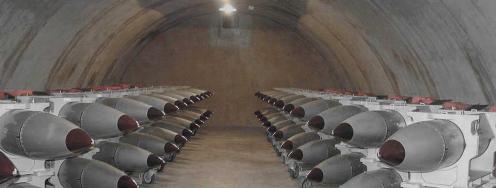New Team, New Term, New Nuclear Policy
On the radar: “Obama’s Nuclear Future”; Lessons on Pakistan’s tac nukes; Interim Pu strategy; Doubts on North Korea sanctions; Queen Noor talks nukes; and Visit Berlin’s loveliest fallout shelter.
On the radar: “Obama’s Nuclear Future”; Lessons on Pakistan’s tac nukes; Interim Pu strategy; Doubts on North Korea sanctions; Queen Noor talks nukes; and Visit Berlin’s loveliest fallout shelter.
March 7, 2013 | Edited by Benjamin Loehrke and Alyssa Demus
Prague agenda returns - After two years of stalled efforts, “recent speeches and press reports indicate [the president] is trying to revive” progress on reducing nuclear risks to the US. The political climate combined with budget austerity, and the president’s new national security team may be just the formula for success, writes Joe Cirincione in Foreign Affairs.
--”All the gears are in motion for the development of a sensible, modern nuclear policy, and Obama has the backing of the Joint Chiefs and much of the American security establishment to achieve it. If he succeeds in finally breaking the grip of Cold War thinking on this central pillar of national security, he will leave a legacy that few presidents have matched.” Read the full article. http://owl.li/ivwFd
Welcome to Early Warning - Subscribe to our morning email or follow us on twitter.
--Have a tip or feedback for the editor? Email earlywarning@ploughshares.org earlywarning@ploughshares.org. Want to support this work? Click here.
Tactical weapons in S. Asia - What does Pakistan’s increasing emphasis on tactical nuclear weapons mean for stability in South Asia? In a new paper for Stimson, David Smith draws from the U.S.-Soviet experience to explore the implications.
--Predictions: (1) new systems' development and acquisition will precede development of doctrines concerning their employment; (2) India will match, if not exceed, whatever numbers of weapons Pakistan eventually builds; and (3) for both sides, fissile material production capacity, and not the number perceived to be needed for deterrence, may be the only limit on stockpile size. Full paper. (pdf) http://bit.ly/13HCET7
Plutonium strategy - The National Nuclear Security Administration acknowledged that it can meet the United States’ near-term plutonium pit needs using existing resources, according to answers provided to Congress from former NNSA administrator Tom D’Agostino. This “interim strategy” would cost $590-$820 million - vastly cheaper than the effectively cancelled $6 billion Chemistry and Metallurgy Research Replacement Nuclear Facility.
--Full answer: “The lower production rate of 30 pits/year, plus the availability of existing off-the-shelf pits, allows NNSA to provide the pits we need on the schedule approved by the Nuclear Weapons Council for at least the next decade.” Kingston Reif at Nukes of Hazard has the story. http://bit.ly/YeRGbh
Skeptical about sanctions - The UN Security Council has agreed on a new round of sanctions against North Korea. There are doubts, however, that the new sanctions will affect Pyongyang’s nuclear intentions for two reasons.
--(1) The effectiveness of the sanctions relies on China’s implementation strategy. “If they offer only words, like before, then (sanctions) will be of little use”; and (2) Unlike export-dependent Iran, “North Korea produces little of value to the rest of the world.” The North has also gotten savvy and “has split up its bank accounts into smaller sums, making them harder to trace,” reports Christine Kim of Reuters. http://owl.li/ivP2O
Tweet - @BBCBreaking: UN Security Council approves fresh sanctions against North Korea in response to nuclear test last month.
Tweet - @RNicholasBurns: #North Korea Bizarre and Dangerous threats--North Korea Warns of Pre-emptive Nuclear Attack http://t.co/86C4vTLkdo
Noor on nukes - "Every nuclear weapon is a catastrophe waiting to happen.” It is therefore “incumbent on the US to work in concert with Russia to reduce both countries’ nuclear arsenals in a process that could then coax the other nuclear states to begin to disarm as well,” said Queen Noor of Jordan in an interview with Yahoo News.
--The Queen is also “profoundly concerned” by the prospect of a preemptive military strike against Iran’s nuclear facilities - "There are many in Israel and in the U.S. and in our region who consider it would be impossible to effectively deal with another country's nuclear program through military strikes,” she says. Watch the interview here. http://owl.li/ivS2f
Tough talk - Remarks made by the U.S. delegate to the IAEA, Joseph Macmanus suggested “the U.S. might push for tougher diplomatic action in the coming months, and indicated America might lobby the IAEA board to ask for a special inspection of Parchin, a facility that the agency suspects was used to test explosive triggers for a nuclear weapon. [Alternatively,] the US [may] seek an IAEA resolution critical of Tehran,” reports the Washington Post. http://owl.li/ivXDr
Unintended consequences - Western sanctions directed at Tehran’s nuclear program are creating medical supply shortages in Iran that are affecting the country’s public. “Washington and Tehran each deserve their fair share of the blame. As they prepare for subsequent rounds of talks in the coming weeks, both sides have an opportunity to put this issue on the agenda,” write Reza Marashi and Trita Parsi in the Huffington Post. Full article here. http://owl.li/ivIMS
Events:
--Sec. George Shultz discusses national security challenges and climate change. March 8 from 12:00-1:00pm in Rayburn 2200. Details, RSVP, and webcast here. http://bit.ly/W2gsih
--”The Presidential Inbox: Iran’s Nuclear Program.” Amb. James Dobbins, RAND; Adm. William J. Fallon, MIT; Karim Sadjadpour, Carnegie. March 7 12:30-2:00 p.m. @ Council on Foreign Relations, New York.
--”Sustaining U.S. Nuclear Forces on a Tight Budget.” Barry Blechman, Russell Rumbaugh, Tom Collina and Daryl Kimball. March 19th from 9:30-11:00am at Carnegie. Details and RSVP. http://bit.ly/XUNrVs
Dessert:
Tweet - @ctbto_alerts: Just discovered a new acronym for #CTBT: Columbus Traveling Beauty Team @CMHTravelBeauty - greetings from Vienna to the CTBT ladies in Ohio!
Nuclear tourism - “Today, at the Pankstrasse stop on the U-8 subway line in Berlin, you can venture into a fallout shelter that was built for about 3,000 people.” Vice has the story of Berlin’s exciting fallout shelter, how it would’ve functioned, and their “suicide-proof” bathrooms. http://bit.ly/VKQpgv



